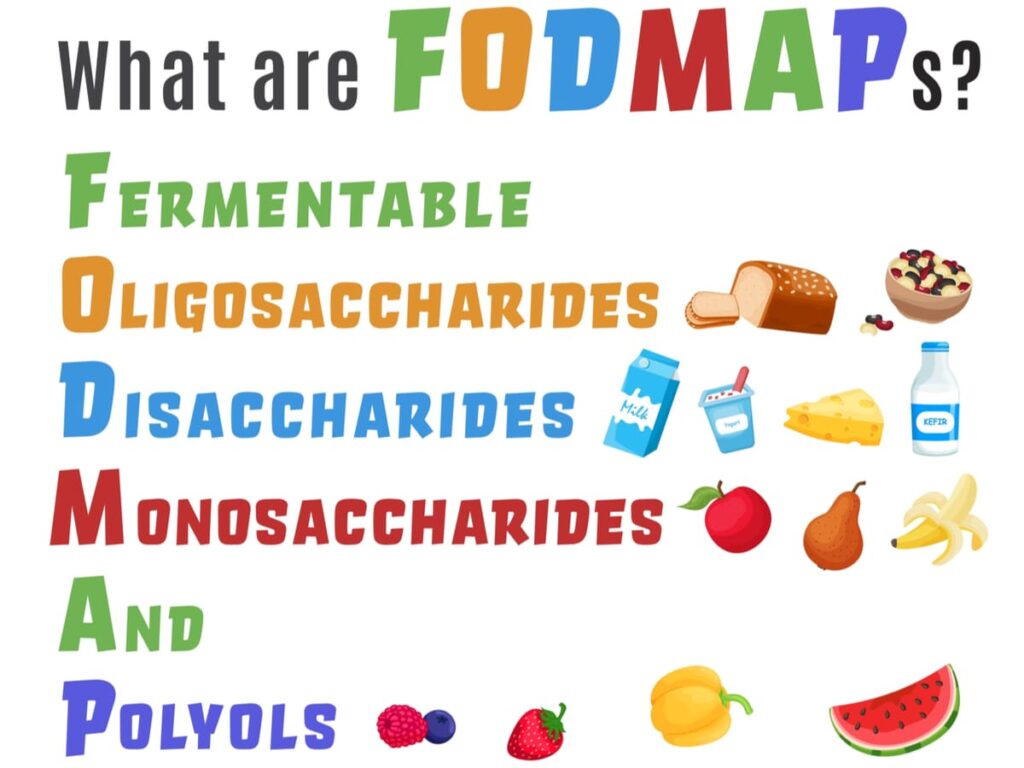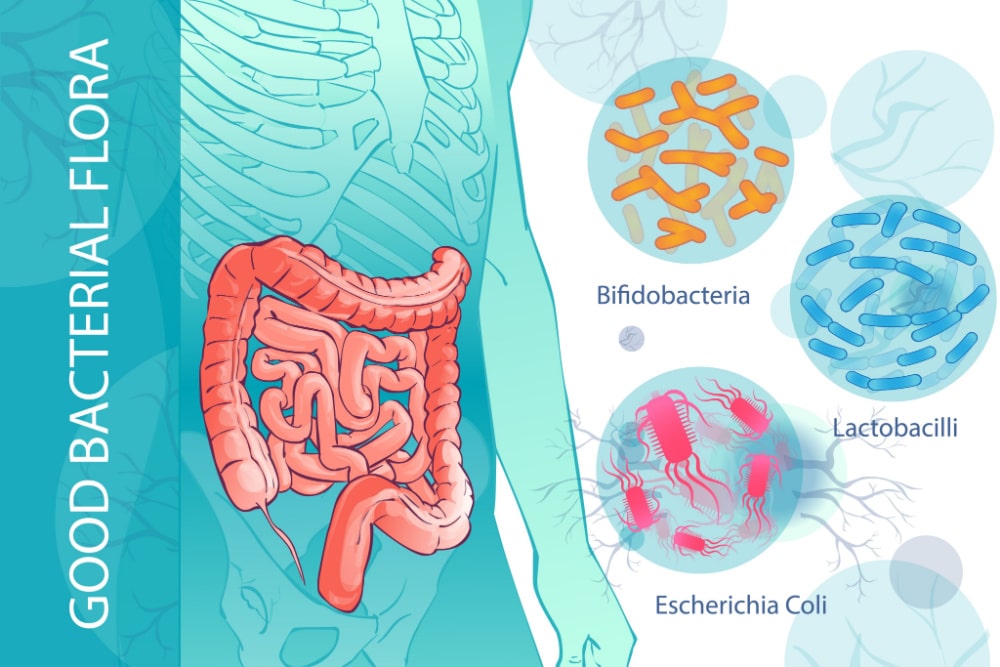
Small intestinal bacterial overgrowth (SIBO) is an overgrowth of bacteria that occurs in the small intestine. SIBO can lead to a variety of gut symptoms which are similar to the symptoms of IBS.
The symptoms that are commonly seen in SIBO and IBS include:
- Bloating
- Distention
- Abdominal pain
- Constipation
- Diarrhoea
Studies have indicated that up to 78% of those with IBS actually have SIBO as the underlying issue. [Source: Pubmed]
The digestive tract is home to the gut microbiome. This is the range of bacteria, yeasts and other organisms such as archaea with 70% of these organisms living in the large intestine. It has been reported that bacteria are the most prevalent out of these microbial species and outnumber the human cells in the body by a factor of 10. This means that we have 10 times as many bacterial cells in the human body as we do human cells. [Source: Pubmed]
These gut organisms provide a wide range of benefits to us to support gut health. The gut microbiome helps us to:
- Digest fibre from food
- Produce short-chain fatty acids (an energy source for the cells that line the digestive tract)
- Production of vitamins (for example, Vitamin K)
- Support the immune system
- Support the regeneration of the gut lining [Source: Pubmed]
SIBO is defined as an increased concentration of bacteria in the small intestine. Changes in the balance of these organisms can impact gut health and contribute to some of the symptoms seen in IBS.
Most of the gut bacteria are found in the large intestine with lower levels found in the small intestine. To keep these bacteria in balance, the digestive system has several mechanisms that help to regulate the gut microbiome.
These include:
- Secretion of digestive enzymes that have antibacterial effects (gastric juice and bile)
- Peristaltic movement prevents the sticking of bacteria to the gut lining
- An appropriate immune response
- Adequate mucin production by intestinal mucosal epithelial cells. This is a protective mucus along the gut lining that inhibits pathogenic bacteria
- The production of antibacterial compounds in the small intestine such as defensins
- A functioning ileocecal valve that prevents the movement of bacteria from the large intestine to the small intestine. [Source: Pubmed, Pubmed, Pubmed]
It is understood that the ‘failure’ of any of these mechanisms can alter the small intestinal ecosystem and then allow for a bacterial overgrowth to occur. [Source: Pubmed]
The small intestine is where food is broken down and digested. The result of changes in the small intestine can impact the way someone reacts to food. This may lead to symptoms of bloating or pain quickly after eating.
SIBO can often be the underlying reason for other IBS symptoms. Commonly including bloating, abdominal pain as well as alterations in bowel patterns. This can include diarrhoea or constipation.
An overgrowth of organisms that produce methane is commonly associated with constipation. When levels of methane are elevated, this is termed methane SIBO however, the term IMO is now being more frequently used. This stands for Intestinal Methane Overgrowth. [Source: Pubmed]
What is Methane SIBO?
Methane SIBO type of overgrowth where the organisms that have overgrown produce methane gas. This is highly associated with constipation. This is due to the ability of methane to impact the ability of the muscles in the gut to contract leading to slow bowel motility. [Source: Pubmed]
The term methane SIBO has also been questioned as it may not be the appropriate way to name this condition. This is primarily due to SIBO referring to bacterial overgrowth and the methane-producing organisms within the gut belonging to the archaea family, which technically speaking are not bacteria. While these were originally defined as bacteria they are now considered separate.
This have lead to the use of the term intestinal methane overgrowth (IMO) rather than the use of the term methane SIBO or methane dominant SIBO. However, as will be mentioned below, it is also possible for certain bacterial species to produce methane. Therefore it may be more accurate to describe the condition as methane SIBO if bacteria as responsible for the elevated levels of methane and to use IMO when archaea are responsible.
The main methane-producing organism in the digestive tract has been identified as Methanobrevibacter smithii. is not possible to assess for the presence of this organism in a SIBO breath test, however, a microbiome analysis can help to identify its presence. with the gut microbiome. [Source: Pubmed, Pubmed]
Methaninobrevibacter smithii is followed by Methanospaera stadmagnae as the second methane producer. The methanogen Methannobrevibacter oralis is present in the oral cavity which is linked to periodontal disease. [Source: Pubmed]
It has also been shown that bacterial species such as Clostridium and Bacteroides also have the ability to produce methane. As mentioned, a microbiome analysis may help to identify which of these organisms is responsible or contributing to the methane levels. [Source: Pubmed]
Also Read >>> Can SIBO Cause Constipation?
What Causes High Methane SIBO?
When addressing SIBO, understanding the underlying mechanisms of the overgrowth can also be a key factor in resolving the symptoms. Numerous factors can contribute to the development of methane SIBO.
The most common causes are:
- Small intestinal dysmotility
- Thyroid imbalances (hypothyroidism)
- A history of food restriction (such as an eating disorder)
- Food poisoning
- Inflammatory bowel disease
- Dyspepsia
- Small bowel diverticula
- Pancreatitis
- Parkinson’s disease
- Diabetes
- Coronary artery disease
- Abdominal surgery (e.g., hysterectomy, gastrectomy, cholecystectomy, and colectomy)
- Medications (PPI) [Source: Pubmed]
There is also a relationship between the balance of fungal species within the gut (such as candida) and methane levels. This relates to the ability of fungi to digestive fibres and produces certain gases in the processes that methanogens (methane-producing organisms) then utilise to produce methane. [Source: Pubmed]
Elevated levels of methane have also been seen in those with the eating disorder Anorexia Nervosa. A study from 2009 found that 100% of those with Anoreixa we found to carry the methane-producing organism, Methanobrevibacter smithii.
The reason for this to happen in Anorexia is this organism plays a key role in the fermentation process in the gut. This means that this elevation of Methanobrevibacter smithii is a way for the gut to adapt to harvest as much nutrition from the food being consumed as possible. When calories are low, this is the way for the body to help us. However, as a consequence of this can be constipation and elevated methane. [Source: Pubmed]
Methane SIBO Symptoms
In SIBO microbial fermentation in the small intestine can produce a range of gases. These gases in SIBO include hydrogen, methane and carbon dioxide. These gases can then contribute to symptoms of Methane SIBO and IBS with include:
- Distention
- Flatulence
- Abdominal pain
- Bloating
- Constipation
- Diarrhoea
However, methane is known to lead to slow gut motility resulting in constipation due to its ability in reducing the muscle contractions in the gut. [Source: Pubmed]
The methane SIBO symptoms can be increased or triggered by certain foods. These foods have to lead to a quick or gradual increase in bloating or distention. This can be noticed within hours of eating trigger foods. The amount of fibre contained in these foods may also contribute to constipation and slower transit time which can build up over several days.
These highly fermentable foods are laid out in a low FODMAP diet. While the low FODMAP diet is of itself not a treatment, it may help to reduce symptoms of methane SIBO while the underlying imbalance and overgrowth are addressed. [Source: Pubmed]
The term FODMAP refers to the various carbohydrates found in foods. This stands for:
F – fermentable
O – oligosaccharides
D – disaccharides
M – monosaccharides
A – and
P – polyols

Oligosaccharides, fructans and galactooligosaccharides are found in foods such as wheat, rye, legumes, onions and garlic. Humans do not produce the enzymes required to break these fibres down therefore the gut bacteria are responsible for their digestion. Alterations in the balance of bacteria in the gut and their ability to digest these fibres are likely a significant contributor to IBS symptoms such as bloating, abdominal pain and gas. [Source: Pubmed]
The disaccharide to be avoided in the restricted phase of the low FODMAP diet is lactose. This is the sugar in milk. Humans do produce the enzyme to digest lactose, however, intestinal inflammation can reduce lactose production which may then lead to improper digestive of lactose with symptoms resulting.
Fructose is a monosaccharide found in fruits such as apples, pears and watermelon as well as in honey and sugar snap peas. It is also used as a sweetener in processed food. Fructose has a high osmotic effect which means it has the ability to draw water into the small bowel. This can then lead to distention with pain and bloating resulting. In high amounts, it may also lead to loose bowel movements.
Polyols are described in 2 forms, sorbitol and mannitol. These are found in apples, pears, stone fruits, cauliflower, mushrooms and snow peas. These are absorbed in a slow manner in a similar fashion to fructose with similar symptoms resulting when malabsorbed. [Source: Pubmed]
High FODMAP Foods
Low FODMAP Alternatives
Vegetables
Artichoke, asparagus, cauliflower, garlic, green peas, mushrooms, onion, sugar snap peas
Aubergine/eggplant, beans (green), bok choy, green capsicum (bell pepper), carrot, cucumber, lettuce, potato, zucchini
Fruits
Apples, apple juice, cherries, dried fruit, mango, nectarines, peaches, pears, plums, watermelon
Cantaloupe, kiwi fruit (green), mandarin, orange, pineapple
Dairy
Cow’s milk, custard, evaporated milk, ice cream, soy milk (made from whole soybeans), sweetened condensed milk, yoghurt
Almond milk, brie/camembert cheese, feta cheese, hard cheeses, lactose-free milk, soy milk (made from soy protein)
Protein
Most legumes/pulses, some marinated meats/poultry/seafood, some processed meats
Eggs, firm tofu, plain cooked meats/poultry/seafood, tempeh
Breads/Cereals
Wheat/rye/barley based breads, breakfast cereals, biscuits and snack products
Corn flakes, oats, quinoa flakes, quinoa/rice/corn pasta, rice cakes (plain), sourdough spelt bread, wheat/rye/barley free breads
Sugar & Confectionary
High fructose corn syrup, honey, sugar free confectionery
Dark chocolate, maple syrup, rice malt syrup, table sugar
Nuts & Seeds
Cashews, pistachios
Macadamias, peanuts, pumpkin seeds/pepitas, walnuts
How to get tested for Methane SIBO?
SIBO breath tests are used to test for SIBO. This is a test where the patient drinks a test solution that either contains lactulose or glucose. This is then followed by the patient collecting a series of breath samples over a 3-hour time period.
As the test solution travels through the digestive system and comes into contact with bacteria it is then fermented. The gases produced during this fermentation process are then absorbed into circulation from the gut where they travel to the lungs before being exhaled. The gas exhaled is collected in the series of breath samples in the SIBO test and then returned to the laboratory for assessment. [Source: Pubmed]
The criteria for a positive methane result are that there needs to be the presence of at least 10 ppm (parts per million) of methane on the test results. [Source: Pubmed]
Approximately 20-50% of the methane produced in the gut is exhaled. The remaining amount is excreted via flatulence. [Source: Pubmed]
It is also known that from measuring methane levels in the healthy population (eg, in those without gut issues) that the population can be divided into methane and non-methane producers. Research has found that up to 35% of the general population can produce methane without having digestive issues. This is another aspect that needs to be taken into consideration when treating methane SIBO and constipation.
Similar research also reported that the absence of methane in the breath samples does not mean that there are no methane producers in the gut microbiome. This is due to a certain threshold of methane in the gut needing to be reached before it can make it’s way to the lungs. [Source: Pubmed]
How is Methane SIBO treated?
Methane SIBO is initially treated by working to reduce the overgrowth of bacteria in the small intestine. The treatment may involve a combination of dietary changes, antibiotic use, probiotics and prebiotics.
It is also important that the underlying issue is addressed. For example, if suboptimal thyroid function is a contributing factor to the presence of these organisms that also need to be taken into consideration.
While it may seem counterintuitive to add use probiotics in SIBO, studies have repeatedly shown the benefits of using probiotics to address SIBO. [Source: Pubmed]
The use of probiotics should not be thought of as adding more bacteria into the small intestine which will then add to the bacterial levels. Instead, probiotics should be seen as organisms that travel through the gut and while they do so they briefly stick to the gut lining and then stimulate the body’s own repair and balancing processes.
The way probiotics work to balance the gut include:
- Balancing the gut microbiota
- Improving the integrity (strength) of the intestinal epithelium (the gut lining)
- Increasing anti-inflammatory messengers and growth factors
- Stimulating the body’s antimicrobials defences
- Production of short-chain and branched-chain fatty acids
- Supporting the brain-gut axis [Source: Pubmed]
Probiotics have also been shown to increase how well antibiotics work in SIBO. The results of a study found that there was greater improvement in SIBO and IBS symptoms when probiotics were used alongside antibiotics rather than just using antibiotics in isolation. [Source: Pubmed]
It is also known that all probiotics are not equal and using the correct strain is a key consideration. When it comes to methane, the probiotic Lactobacillus reuteri (DSM 17938) was shown to improve constipation as well as lower methane levels. [Source: Pubmed]
It has been reported that 44% of those treated for SIBO can relapse within 9 months. This can be more likely to happen if the right bacteria have not been targeted or if other contributing factors to the methane SIBO are ongoing. [Source: Pubmed]
What Naturally Kills SIBO?
Natural approaches to reduce the level of organisms in the gut include herbal antimicrobials. There are herbal supplements or extracts several of which have also been studied and compared to antibiotics for treating SIBO.
A 2014 study concluded that antimicrobial herbs were as effective as antibiotics in treating SIBO. The herbs included in the antimicrobial formulas used in the study include:
- Oregano oil
- Thyme
- Lemon balm
- Coptis
- Pau D’arco [Source: Pubmed]
In addition to this study, research has also shown that other herbs have the ability to reduce methane levels. These include:
- Garlic (allicin) [Source: Pubmed]
- Neem [Source: Pubmed]
- Clove oil [Source: Pubmed]
- Peppermint oil [Source: Pubmed]
Alongside antimicrobials, probiotics and prebiotics have been shown to increase how well these approaches work at reducing the levels of bacteria in SIBO. [Source: Pubmed, Wiley]
Prebiotics for Methane SIBO
The prebiotic fibre PHGG (partially hydrolyzed guar gum) has been shown to improve a range of the symptoms seen in methane SIBO. A 2014 study found that the use of PHGG:
- Improved bowel movements
- Reduced the need for laxatives and enema usage
- Reduced abdominal bloating
PHGG has been shown to increase the levels of key gut bacteria Bifidobacteria and Lactobacilli. These key gut bacteria are understood to support the gut microbiome and help to regulate the gut ecosystem.
The use of PHGG has also been shown to increase the levels of butyric acid within the gut, which is a key energy source for the cells that line the gut. Its ability to support levels of butyric acid can improve the microbial ecosystem and make it a less favourable environment for potentially pathogenic organisms. [Source: Pubmed. Pubmed]

The use of PHGG has been shown to reduce methane levels in the gut which can be a central way in which it improves constipation. This can be the result of its ability to reduce the levels of methane-producing bacteria such as Clostridium species. [Source: Pubmed]
Methane-lowering effects have also been seen with the use of GOS and inulin, however as these can produce high levels of gas they may not be as well tolerated. [Source: Source]
Foods to Reduce Methane in the Gut Naturally
While certain foods can be limited in the short term (e.g. FODMAPS) to help manage symptoms, including other foods can help to reduce methane levels.
Polyphenols are compounds found in high amounts if fruits, vegetables and other plant foods that have a range of health benefits. This is understood to be through their antioxidant properties and also through their beneficial action on the gut microbiome.
Polyphenols have been shown to have a protective effect from conditions such as:
- Cancer
- Asthma
- Heart disease
- Diabetes
- Infections
The benefit to the gut microbiome can be through their direct antimicrobial properties and also their ability to modify and improve the gut microbiome. [Source: Pubmed, Pubmed]
Polyphenolic compounds are the compounds that give fruits and vegetables their colourful appearance. Foods with high levels of polyphenols include:
- Grapes
- Apples
- Pear
- Cherries
- Berries
- Red wine
- Tea
- Coffee
- Unprocessed cereals
- Legumes
- Dark chocolate [Source: Pubmed]
This reinforces the notion that a diverse and varied diet is central to supporting gut health and overall welling being. However, if there are food intolerances or food reactions, high-FODMAP foods may need to be avoided in the medium term.
Also Read: How To Reduce Inflammation In The Gut
SIBO Constipation Treatment
For constipation support, other factors can be considered to support bowel movements. Often, a combination can be considered with the use of the following:
In addition to this, ensuring optimal Vitamin D status is important as is, ensuring adequate hydration. [Source: Pubmed, Pubmed]
As constipation or slow bowel motility can lead to bacterial imbalances, a key part of the therapeutic process is to encourage a daily bowel movement.
The position of the body has also been shown to help support bowel movements to provide a more satisfying bowel movement. This has been shown in studies into identifying the best position to be in when passing a stool.
The study compared squatting to the seated position (eg the normal position on a toilet) where it was concluded that squatting led to a significantly increased sensation of a satisfactory bowel movement. The key factor is having the knees above the hips, something that can be recreated without actually squatting but placing a small stool under the feet when on the toilet to elevate the knees. [Source: Pubmed]
Methane SIBO Diet
Diet can have a significant impact on digestive symptoms. A low FODMAP diet can often be helpful for managing symptoms by reducing the levels of fermentable fibres in the diet. While this does help with symptoms it would not be considered a treatment to lower the bacterial overgrowth in SIBO. [Source: Pubmed]
However, when constipation is present the level of fibre can impact bowel motility. This largely depends on the individual and their microbiome. In some, a low FODMAP diet may improve bowel movements while in others it may worsen constipation.
This is where working to address the underlying imbalance is key so that a restricted diet doesn’t need to be followed. In addition to the foods being limited, the diversity of plant foods and polyphenols in the diet is an important focus to have.
Microbiome Support for Methane SIBO
Methane is a by-product of bacterial fermentation. This occurs during the digestion of certain foods.
When levels of this gas are elevated it may cause bloating, pain, and constipation. If the SIBO is related to methane production, then microbiome support would be helpful to reduce the production of methane gas. The microbiome is often supported through probiotics and prebiotics as well as the use of antimicrobial herbs.
A prebiotic like PHGG (partially hydrolysed guar gum) boosts good bacteria that fight inflammation, improves the transit time of food and nutrients, and restores a healthy microbial balance. [Source: Pubmed]
A balanced flora with butyrate-producing bacteria and Bifidobacteria may help to reduce methane production and improve the microbiome profile. This has also been indicated to reduce methane levels and improve the efficacy of antimicrobial therapy. [Source: Pubmed]
Certain probiotics are clinically tested for their ability to improve constipation. Bifidobacterium lactis has been used for an increased transit time, while Bifidobacterium infantis helps to lower increased methane levels. Lactobacillus reuteri also helps with chronic constipation by decreasing methane production.
When it comes to prebiotics and probiotics, it’s essential to find the balance and right strain for the patient. For some, using the wrong product or quantity may lead to a worsening of symptoms. [Source: Pubmed]
Why might you need to treat hydrogen SIBO as well?
Hydrogen SIBO is a condition in which the bacteria produce hydrogen gas in your small intestine.
The following can cause or contribute to hydrogen SIBO:
- Constipation
- Antibiotics
- Poor diet
- H. pylori infection
- Pancreatic insufficiency
- Age (older adults)
Methane is made from hydrogen therefore when reducing the levels of the organisms that produce methane (from hydrogen) may lead to more hydrogen is present in the gut. For some, this can lead to an increase in gas and bloating as the gut microbiome is supported. [Source: Pubmed]
How long does it take to treat methane SIBO?
Studies offer an indication of how long the treatment might take to address methane SIBO. Studies using herbal antimicrobials have been run over a 4-week time period with studies into antibiotics between 1 week and 4 weeks. [Source: Pubmed]
While antimicrobial approaches may offer an improvement in symptoms in a short space of time prebiotics can also be considered. In particular the low FODMAP prebiotic PHGG has been shown to reduce methane levels. The studies into this prebiotic were over a 1-3 month time frame. While this is over a longer period of time, supporting the growth of the microbes in the gut can improve the ecosystem of the small and large intestines and lead to better long-term gut health outcomes. [Source: Pubmed]
It has also been shown that a combination of antimicrobials and PHGG increases the efficacy of treatment when compared to taking antimicrobials in isolation. [Source: Pubmed]
Methane SIBO Foods to Avoid
When treating gut issues it’s important to keep the diet varied and colourful. This is due to the role of fibre in the diet to support the balance of the gut microbiome, feeding key species that regulate the gut ecosystem.
This can be referred to as the Mediterranean diet which involves key factors such as:
- Fruits
- Vegetables
- Whole grains
- High-quality protein
Alongside this, limiting the foods that lead to dysbiosis is also important. These are the foods that are commonly eaten in high amounts in the Western Diet.
These foods include:
- Refined carbohydrates and sugars
- Processed meat
- Processes and refined oils [Source: Pubmed]
In addition to this foundational diet, a low FODMAP diet can also be considered. This diet removes highly fermentable foods from the diet that can lead to symptoms such as gas and constipation if SIBO is present. Rather than being a treatment, a low FODMAP diet can be considered a symptom management strategy.
It has also been shown that following a low FODMAP diet for a long period of time can lead to negative changes in the gut microbiome. This is due to the beneficial bacteria not receiving the fibre they need to grow. [Source: Pubmed]
Gut Health Nutritionists
There can be many aspects to take into consideration when addressing SIBO and methane overgrowths.
Working with a gut health specialist can guide you through this process and help you get your gut health back on track.






